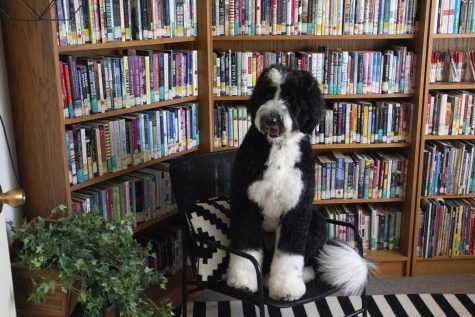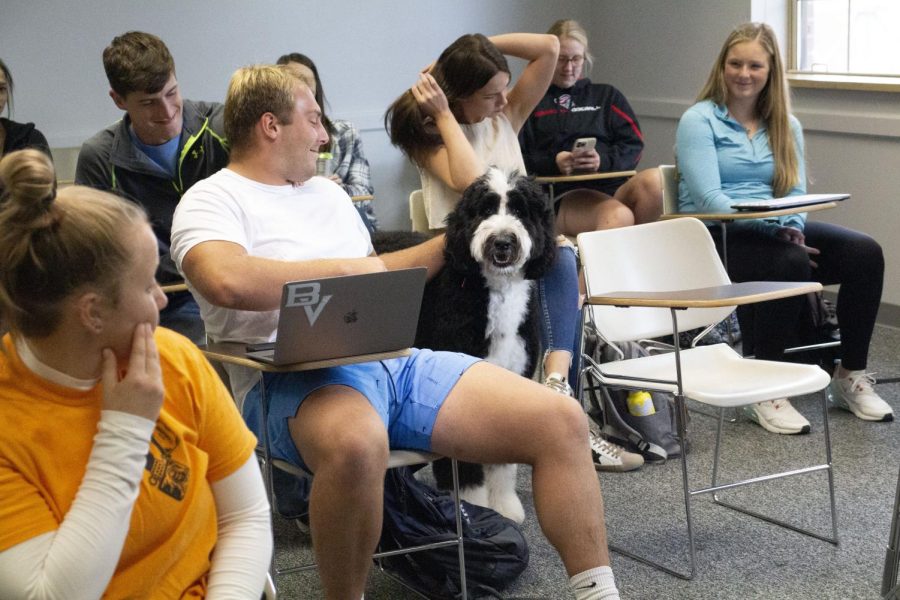Therapy Dogs in Educational Settings: Dogs with Jobs
October 22, 2022
When a student enters Dr. Calle Friesen’s office, they are greeted not only by someone who is an Associates Professor in the field of education at BVU but also by a fellow companion. In the office sits a gentle giant, one who is reminiscent of a big teddy bear. He is usually the first to greet the newcomer to the room. He immediately rises to see who has come to visit on any occasion. There is some sniffing, panting, tail wagging, and the expectation that the visitor will pet him. Meet Cooper, the School of Education’s therapy dog.

According to Donna Musel, director of the Center for Academic Excellence (CAE), she has discovered that there are many types of jobs for dogs but not all of them can be service dogs. A service dog is trained with the intentions of only assisting a specific person. Working dogs are those trained for a specific job such as police dogs, military use, or search and rescue. There are also therapy dogs; these dogs are not emotional support animals. Emotional support animals (ESA) generally do not have any further training other than basic commands to provide comfort and be a source of companionship for their owner. There are numerous ESA dogs and cats on campus, but they are different from therapy animals that go through training. Therapy dogs are professionally trained to work with larger groups of people and have training for certain environments such as the classroom, hospitals, and workspaces.
“The typical working dog is a larger dog. They are usually golden retrievers, labs, or some sort of doodle,” said Musel. Cooper is a two-year-old doodle.
“Cooper is trained for schools, libraries, and hospitals. He is also trained for groups of people. Mainly young adults, and children,” said Dr. Friesen, Cooper’s handler.
According to Dr. Friesen, Cooper started his training as a puppy. At six months, he was sent to Smokin’ Dakota Kennels in South Dakota, an organization that specializes in therapy training. He lived there for four weeks without any home visits and breaks. Not only did Cooper go through training but so did Dr. Friesen. She had to learn all his commands and training methods to correct behaviors that were unwanted.
Dr. Friesen demonstrated some of what Cooper learned from training by having him pick out children’s books. She picked out three books and gave him two of the three books to choose from. After making his selection by poking the book with his nose, she took the third book and mixed it up with the book he selected. She then directed him to pick a book. Cooper obeyed and selected the same book that he picked out from the first two options.
“Cooper has specific training protocol for schools,” she continued. “He knows when you prefer not to interact with him, such as not reaching out to him. He approaches class by greeting everyone who is already in class and then as people come in. He then circulates class giving most of his attention to people he thinks might need more attention due to his empathic personality.”

On October 4, Cooper entered an education class with Friesen. Students in the classroom welcomed him with excitement. As he wandered around the classroom, students engaged with the 90-pound, fluffy, black-and-white dog differently. Some called his name so he would come over while others quietly pet him as he walked by.
Senior secondary math major Landon Weber said, “Having Cooper in the classroom helps everyone feel more at ease. He is also a huge help for the students who may be feeling stressed out. Getting to pet or hang out with a dog can be therapeutic.”
Not only does Cooper know BVU’s education students from the classroom, but he also meets others from his walks in the forum or during the office hours that they hold for him in the relaxation room.

According to Friesen, therapy dogs are now becoming more popular within grades K-12 and higher education. In some schools, dogs are brought in on a regular basis rather than just during finals or special occasions. The idea behind having therapy dogs in a learning environment has many health benefits. These benefits are lower heart rate, lower stress levels, and assistive opportunities for open communication with those who struggle to express themselves amongst other people. Ultimately, service dogs can provide comfort to a vast majority of people who often struggle with a deficiency of companionship or mental health.








